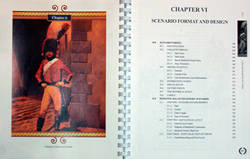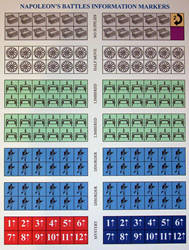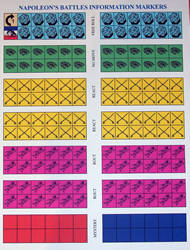|
Review
Napoleon's
Battles 2nd Edition
By
Richard Moore
Reactions
from Gamers to Napoleon's Battles
Send
in your view on Napoleon's Battles 2nd Edition rules
Buy
miniatures at auction on Ebay
 The
long-awaited second edition of the classic miniatures
rules set Napoleon's Battles has arrived and
you can guarantee there will be loud celebrations
around many of the world's gaming communities. The
long-awaited second edition of the classic miniatures
rules set Napoleon's Battles has arrived and
you can guarantee there will be loud celebrations
around many of the world's gaming communities.
In
Napoleon's Battles action is at brigade level
with an inch (2.5cm) of tabletop equal to 100 yards
(just under 100 metres), an infantry figure representing
120 troops, a cavalryman 80 troopers and a cannon
is a battery of four to eight guns.
It
is designed for 15mm figures (although is adaptable)
with large-scale Revolutionary and Napoleonic Wars
battles in mind - such as Waterloo - and to be both
a simulation and a playable game.
That
is a tough ask and there are divided
opinions among gamers on whether such a balancing
act was managed. Just look through some chat rooms
and you see a major rules schism in the gaming community.
 Napoleon's
Battles wins a lot of friends on the playability
side, but loses some folk on the realism stakes. Napoleon's
Battles wins a lot of friends on the playability
side, but loses some folk on the realism stakes.
Mind
you since first hitting wargames tables way back in
1989, Napoleon's Battles has become the No.1
selling way of refighting Napoleonic miniatures battles
and being that successful always cops brickbats -
no matter how good it is.
For
this chap, it really comes down to what you want to
get out of a game. Do
you want to be a stickler for accuracy down to the
last application of crossbelt pipeclay, or would you
rather smash the living daylights out of an opponent
in an important battle?
2500
Commanders rated
 The
second edition of Napoleon's Battles is being
published by Five Forks and the original designers
Craig Taylor and Robert Coggins have revised the system,
tweaking some of the rules and adding in an enormous
amount of new reference material. The
second edition of Napoleon's Battles is being
published by Five Forks and the original designers
Craig Taylor and Robert Coggins have revised the system,
tweaking some of the rules and adding in an enormous
amount of new reference material.
There
has been a massive boost in the number of generals
and the list of their rated abilities so now you can
look through more than 2500 of the leading soldiers
of the time and - if nothing else - you can either
agree or disagree with how the designers have rated
your favourite leader.
This
is fun - although I can only imagine Baron de Marbot
rolling in his grave after only copping an average
rating (deserved though that may be), and there would
be more than a few newly raised eyebrows at Robert
Craufurd being given an excellent mark.
Troops
Re-Evaluated
And
Taylor and Coggins have used recent information to
re-evaluate some of the units taking part in the battles
between 1792 and 1815.
This
includes the artillery and now the ratings reflect
nation's big guns, training and even powder quality.
The
infantry changes see the Dutch Belgians becoming slightly
better, while the Brunswickers lose a few points.
All
up there are ratings for more than 350 combat units
from 14 countries and each is given one of 13 different
levels of capability.
Excellent
Look
 The
rule book is large, comprehensive and takes one heck
of a lot of reading, but seems to cover every aspect
you need to know to take charge of a Napoleonic clash.
If you have played boardgames then the layout will
be very familiar. The
rule book is large, comprehensive and takes one heck
of a lot of reading, but seems to cover every aspect
you need to know to take charge of a Napoleonic clash.
If you have played boardgames then the layout will
be very familiar.
I
have to say Five Forks has done a superb job with
the presentation of the rules and the meanings of
the counters are clear and distinctive, although they
come on cardstock rather than being die-cut counters.
Those will be available from Five Forks at a later
stage - at a "moderate charge" according
to the company. It would have been nice for them to
have been included in the package.
The
layout of the rules book is very clean and finding
your way around the 180-page folder is a breeze. The
cost of the 2nd edition Napoleon's Battles is $US40.
Handy
Advice for beginners
For
newcomers to table-top miniatures wargaming, Five
Forks includes an introduction to the hobby that explains
everything you need to know about gaming.
It also gives some fine advice on creating your own
miniatures army, how to paint it, as well as hints
on making terrain to boost the look and feel of the
battles.
Each
right-hand page of the folder has a quote from Napoleon
Bonaparte and there are eight colour images from renowned
battle artist Keith Rocco.
Main
Rule Changes
But
most of all gamers will want to know what the main
rules changes are - so here they are:
- A
simplified wheeling movement in the standard game
(The original rule has been moved to the Optional
Rules).
- Close
formation changes
- Emergency
horse-artillery unlimbering
- Liar's
Reserves where you can do hidden movement without
record keeping
- Artillery
crews will be able to rout on their guns if their
battery is not occupied
- Alternating
Combat Order
- Expanded
supply rules that even allows for looting
- Cossacks
can withdraw if faced by attacking formed cavalry
-
Alternate Combat Order of Choice: The choice of
the order in which combats are resolved. (In the
First Edition, the phasing player determined the
order of combat resolution. The new optional rule
allows for the alternate resolution of combats from
the phasing to the non-phasing player.)
- Expanded
Rules for Supply: This includes expanded rules for
supply lines, a rule for looting and modifiers to
allow for problems with discipline.
The
Battles
Some
of the classic struggles you can fight with Napoleon's
Battles (2nd) are Valmy, Marengo, Auerstadt, Talavera,
Albuera, Lutzen and Craonne, with new and revised
scenarios for:
- Novi
(August 15, 1799): Russian general Suvarov's victory
over the French in northern Italy.
- Raab
(June 14, 1809): Eugene Beauharnais' victory over
Austria's Archduke John.
- Gorodetschna
(August 12, 1812): Napoleon's Austrian and Saxon
allies take on the Russians.
- Quatre
Bras (June 16, 1815): Wellington versus Ney at the
crossroads that can decide the 100 Days' Campaign.
- Waterloo
(June 18, 1815): Wellington and Blucher line up
against Napoleon in the deciding battle of the Napoleonic
Wars. There have been changes to the order of battle,
arrival times of units and a re-evaluation of many
of the units.
The rules book includes:
- Standard
Rules and Optional Rules with numbered paragraphs
for easy reference.
- Over
350 combat units rated in 13 categories.
- A
points system allowing gamers to design their own
scenarios.
- Ratings
for over 2500 generals who served from 1792 to 1815,
each rated each in four key command categories.
- Scenario
design toolkit for gamers.
- Basic
information on how to paint and assemble a miniature
army and terrain.
- A
review of all the major and minor armies of the
era.
Contained
within the set are:
- 168
Markers.
- 14
Army Cards for the major and minor European Powers.
- Combat
and Movement charts and tables.
- Artillery
template and Manouevre template.
- Spread
Artillery Fire template.
- Brigade
Skirmish template.
- Time
Record Chart.
Conclusion
The
type of battle you want to fight - tactical versus
more strategic, or realistic versus more playable
- will determine whether or not you want to play Napoleon's
Battles' rules.
If
you have the first edition then the revised version
will be a must buy.
If you are a newcomer to miniatures then it very much
comes down to the time you want to spend fighting
a battle, the complexity of the rules you want to
learn, the size of the area you have to fight in and
the overall grand look of the miniatures clash.
For
mine, taking the field with an affordable 15mm army
and being able to fight the large battles is a bonus
that gives Napoleon's Battles a huge advantage
in my eyes.
|



 The
long-awaited second edition of the classic miniatures
rules set Napoleon's Battles has arrived and
you can guarantee there will be loud celebrations
around many of the world's gaming communities.
The
long-awaited second edition of the classic miniatures
rules set Napoleon's Battles has arrived and
you can guarantee there will be loud celebrations
around many of the world's gaming communities.  Napoleon's
Battles wins a lot of friends on the playability
side, but loses some folk on the realism stakes.
Napoleon's
Battles wins a lot of friends on the playability
side, but loses some folk on the realism stakes.  The
second edition of Napoleon's Battles is being
published by Five Forks and the original designers
Craig Taylor and Robert Coggins have revised the system,
tweaking some of the rules and adding in an enormous
amount of new reference material.
The
second edition of Napoleon's Battles is being
published by Five Forks and the original designers
Craig Taylor and Robert Coggins have revised the system,
tweaking some of the rules and adding in an enormous
amount of new reference material.  The
rule book is large, comprehensive and takes one heck
of a lot of reading, but seems to cover every aspect
you need to know to take charge of a Napoleonic clash.
If you have played boardgames then the layout will
be very familiar.
The
rule book is large, comprehensive and takes one heck
of a lot of reading, but seems to cover every aspect
you need to know to take charge of a Napoleonic clash.
If you have played boardgames then the layout will
be very familiar.